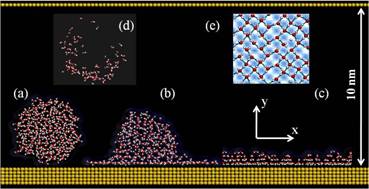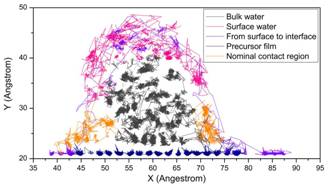PRL Reports MD Simulations New Results of EEC from IMECH
Updatetime:2010-06-24From:
【Enlarge】【Reduce】
Supported by the Ministry of Science and Technology (MOST), Chinese Academy of Sciences (CAS) and the National Natural Science Foundation of China (NSFC), the research group of “Mechanics in Micro- and nano- systems and Physical Mechanics” from Institute of Mechanics (IMECH), CAS, achieves new research progress in the molecular dynamics (MD) simulations of wetting, electrowetting and electro-elasto-capillarity (EEC), which was published as cover story on the “Physical Review Letter (PRL)” (Yuan QZ and Zhao YP*. Precursor film in dynamic wetting, electrowetting and electro-elasto-capillarity. Physical Review Letters, 104 (24): 268101 (2010)) (Figure 1)
.Dynamic wetting and electrowetting is of great importance where fundamental researches (physics, chemistry, biology, etc.) and industry (aerospace, automobile, petroleum, etc.) intersect, which relate to the classical problem of "Moving Contact Line (MCL)". As pointed by the "Huh & Scriven paradox", the no-slip boundary condition in the hydrodynamics would induce infinite energy dissipation in the corner of the three-phase contact line. Thus, a very thin (usually a single molecular layer) precursor film (PF), which is driven by the disjoining pressure and propagating ahead of the nominal contact line, is a crucial part in the wetting and electrowetting process. (1) In the wetting process, PF propagates quickly, then droplet propagates above PF. (2) In the electrowetting process, a typical electric energy in PF cannot be neglected in comparison to the thermal energy, which makes unique properties of PF. However, there exists no study on PF in the electrowetting process. There is still lacking of understandings about PF in the wetting process.
Professor ZHAO Yapu and his Ph.D. student YUAN Quanzi studied the unique properties and important functions of PF in wetting, electrowetting and EEC, employing a combined method of MD simulations (Figure 2) and the molecular kinetic theory (MKT). Their results have recently been published as the cover paper in the PRL. The new results in this PRL cover paper are as follows:
1. (a) The spreading radius R of PF obeys the power law with respect to the spreading time t (R~tn(E)), where n(E) is a function of the electric field E. (b) Owing to the fast diffusion from the surface water molecules of the droplet to the front of PF, PF propagates fast, but with low energy dissipation (Figure 3). (c) There is a unique 2 dimensional hydrogen-bond network in PF (Figure 2e). (d) Owing to the pinning of the substrate, PF is solid-like, whose self-diffusion coefficient is much less than bulk water. PF induces atomic details to eliminate the infinite energy dissipation due to the no-slip boundary condition. PF can be an answer to the "Huh & Scriven paradox".
2. ZHAN and YUAN proposed and realized EEC in MD simulations. When the size of a droplet is larger than "elaso-capilary length", soft film can wrap the droplet automatically. When external electric field is induced to this system, EEC would happen. PF pushes the soft film to unwrap the droplet under electrostatic force. EEC exihibits the important role of PF in the electrowetting process, as well as a potential application in nano/micro drug delivery.
The PRL referees highly evaluate this work “The Letter suggests a novel mechanism of contact line propagation and provides an important contribution to studies of dynamics of wetting.”; "The paper raises a lot of fundamental and technical questions.” Owing to the novelty and importance of this Letter, PRL selects it to be the cover story in Issue 24,

Figure 1. The cover paper in Issue 24, Volume 104, PRL, exhibiting the dynamics process of electro-elasto-capillarity (EEC) and the interactions between the precursor film and the soft film.

Figure 2. The wetting and electrowetting processes. (Picture/ZHAO Yapu and YUAN Quanzi)

Figure 3. The path lines, which belong to water molecules in different region, in the wetting process. (Picture/ZHAO Yapu and YUAN Quanzi)
Appendix




